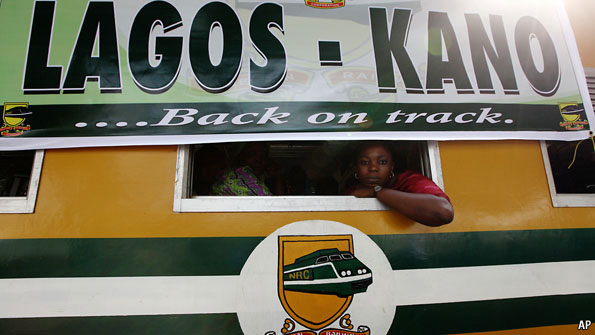
To most analysts, President Goodluck Jonathan’s name will be written in gold for his administration’s pragmatic efforts at reviving the Nigerian Railway Corporation (NRC) which has been comatose for nearly 30 years.
They note that the feat is even more evident with the president’s recent inauguration of two Diesel Multiple Units (DMUs) train sets and six air-conditioned passengers’ coaches at the NRC terminus in Lagos.
“This is part of the concerted efforts of our administration to steadily improve the railway rolling stock. It is the beginning. Within the next few months, more rolling stocks will be delivered.
These coaches are in three faces, Economy class, 1st class seater & 1st class sleeper all fully air conditioned.
BRAKES let out a deafening screech and steam fills the station as the Lagos -Kano train ends its 30-hour journey. Hundreds of passengers emerge wearily from brightly painted yellow, green and white carriages. It may be sweaty, crowded and very late, but after a ten-year absence this revamped link between Nigeria’s two biggest cities is a welcome relief. Travelling the 1,126km (700 miles) at an average speed of less than 50km an hour with endless stops, it is no wonder the trip takes so long. But for most Nigerians the low fares are worth it. A second-class ticket from Lagos to Kano costs around $12, roughly a quarter of the price of a more treacherous bus ride. “Hundreds of people were waiting at Ilorin [300km north of Lagos] but there wasn’t enough space for us all,” says a mother trying to appease a screaming child on her hip. “I had to stand the whole way.”
These coaches are in three faces, Economy class, 1st class seater & 1st class sleeper all fully air conditioned.

The service was relaunched in recent months, after improvements costing about $166m. Nigeria’s railways, started in 1898, have deteriorated in the past 20 years owing to those old engines of decay, corruption and mismanagement. Nigerians’ domestic travel options are limited. Most cannot afford to go by air, so take to the roads. Overfilled lorries, usually packed with dozens of passengers sitting on cargo, precariously negotiate crater-sized potholes. One stretch of road, nicknamed “Bauchi or Death”, after a northern state, is littered with overturned lorries and cars.
The success of the Lagos-Kano route, however slow, indicates the demand for a modern rail network . There are plans to invest in rehabilitating lines along the eastern corridor between Port Harcourt in the south and Maiduguri in the north-east. There is even talk of monorails in a couple of cities. As people scramble on board the new train, it is clear that the Nigerian Railway Corporation will be puffing hard to keep up with demand.As well as being dangerous, Nigeria’s woeful transport network slows the economy. A rejuvenated rail network could unplug one of the biggest business bottlenecks. In the short run, freight trains are the priority. The cost of transporting goods on passenger trains is prohibitively expensive. “The charge is almost impossible,” complains Jibrin Bala, a cloth merchant. “On our way here, we had to transfer our goods onto buses.”


“It is a very welcome development to our nation, Nigeria and to the Centre of Excellence, Lagos State. No doubt, we require this infrastructure.
“We appreciate it and we will continue to give every moral support that the corporation requires as we now have complementary services in the transport system of Lagos State, “ the governor said.
Shedding more light on the progress so far achieved in the railway transformation agenda, Mr Adeseyi Sijuwade, the Managing Director of NRC, also said that significant part of the Eastern Line rehabilitation would be completed by the third quarter of 2014.
“The corporation would continue to pursue its vision, mission, and core values to attain its mandate of carriage of passengers and goods in a manner that is safe, reliable and affordable,” he said.
The Jonathan’s administration also inaugurated the revitalised Lagos-Jebba rail lines, a project which cost the government over N12 billion.
To add value to the initiative, the NRC had also launched its Mass Transit Train Service (MTTS) in Lagos.
Available records show that the corporation has deployed 11 trains, carrying close to 15,000 passengers daily within the Lagos metropolis.
Commuters say the introduction of the intra-city train service in Lagos has reduced the cost of transportation in the area.
For instance, a returned trip from Agege – Ebute Metta under the MTTS now costs less than N150, as against the more than N1,000 it would have cost by taxi, while it now costs about N180 only by train service from Lagos to Abeokuta.
The resuscitation of the train service has also reduced the cost of transportation from Lagos to Kano, which now costs less than N1,800 as against between N4,000 and N5,000 by car or bus.
Industry watchers also believe that the completion of Lagos-Maiduguri standard gauge will make it cheaper and faster to move goods and services from Lagos to the north-eastern part of the country.
The Federal Government also signed a N67 billion contract for the rehabilitation of the 2,119 kilometres three Eastern rail lines.
This comprises the 463 km rail line from Port Harcourt to Makurdi; 1,016 km rail line from Makurdi to Kuru, including spur line to Jos and Kafanchan; and 640 km rail line from Kuru to Maiduguri.
Available records showed that appreciable progress had been made in the completion of the 1,657km Eastern line from Port Harcourt to Maiduguri.
Besides, the administration says it has also procured 25 new locomotives from General Electric and refurbished 366 coaches and wagons, among others.
This is in addition to the 20 units of oil tank wagons, five railroad emergency vehicles, 60 tonnes overhead workshop cranes and three rail inspection vehicles.
Records further showed that the Iddo terminus station, Ebute Metta junction station, Ilorin station, Kaduna junction station, Kano station, Port Harcourt station, Enugu station, Jos station and Gombe station were also being remodeled.
No comments:
Post a Comment